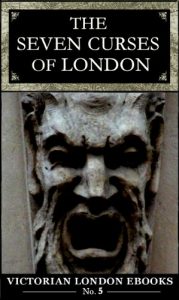"To certain squeamish readers this useful and well-written volume will prove an unsavoury book; and even to those who have the nerve to witness agony and explore the lurking-places of crime, it will occasion no ordinary sadness and sense of repugnance. Redolent with the unwholesome smell of ill-drained alleys and over-crowded dwellings for the poor, it resounds in every chapter with the cries of violence and the mutterings of woe ..." [review of The Seven Curses of London from the Athenaeum, 1869]
James Greenwood (c.1835-1927) was one of eleven children, born to a Lambeth coach trimmer. His elder brother Frederick, initially apprenticed to a publishing/printing firm, became a writer and editor; and it was under his brother's guidance that Greenwood wrote an article entitled 'A Night in a Workhouse' (pub. Pall Mall Gazette, 12-15 January 1866). This was a ground-breaking piece of undercover reporting, in which Greenwood spent the night in a 'casual ward' disguised as a pauper. In the style of the period, the article was anonymous, with Greenwood bestowing on himself the soubriquet of 'The Amateur Casual'. The article's exposé of maladministration and wretched conditions — and the exotic manner in which the information was gathered — sealed the author's reputation overnight.
Greenwood would continue to expose various aspects of London 'low life' for several decades, writing for the Pall Mall Gazette and then the Daily Telegraph. Many of these were anthologised into book form, but The Seven Curses of London was written as a single campaigning work, designed to stimulate debate about the manifold evils which beset the urban poor. It is not, however, a simple tract and the book includes many of the staples of Greenwood's distinctive style of journalism, including investigative reporting and interviews.
The 'Curses' themselves are: 1. Neglected Children 2. Professional Thieves 3. Professional Beggars 4. Fallen Women 5. Drunkenness 6. Betting Gamblers 7. Waste of Charity. There is more of Greenwood's 'undercover' work, including a visit to a 'baby-farmer' — one of those women who advertised in the press to 'adopt' unwanted children for a fee (the fate of such unfortunates was often criminal abuse or neglect). Other vivid passages include interviews with convicts; begging-letter writers; harangues against the corrupting influence of penny dreadfuls (sample prose: "... pouting coral lips, in which a thousand tiny imps of love are lurking ..."); the unfortunate class of prostitutes known as 'dress-lodgers'; a full list of the ingredients used to adulterate beer ("... Multum is a mixture of opium and other ingredients, used to increase the intoxicating qualities of the liquor ... "); a survey of betting scams ("... Mr. Ben W. will forfeit £500 if he does not send first and second for the Chester Cup. Send four stamps and stamped envelope, and promise a present, and I will send you the Chester Cup, Great Northern, Derby, and Oaks winners ...") and a good deal more. All of these combine to paint a revealing picture of life in 1860s London, making this book worthy of your attention.
Lee Jackson
James Greenwood (c.1835-1927) was one of eleven children, born to a Lambeth coach trimmer. His elder brother Frederick, initially apprenticed to a publishing/printing firm, became a writer and editor; and it was under his brother's guidance that Greenwood wrote an article entitled 'A Night in a Workhouse' (pub. Pall Mall Gazette, 12-15 January 1866). This was a ground-breaking piece of undercover reporting, in which Greenwood spent the night in a 'casual ward' disguised as a pauper. In the style of the period, the article was anonymous, with Greenwood bestowing on himself the soubriquet of 'The Amateur Casual'. The article's exposé of maladministration and wretched conditions — and the exotic manner in which the information was gathered — sealed the author's reputation overnight.
Greenwood would continue to expose various aspects of London 'low life' for several decades, writing for the Pall Mall Gazette and then the Daily Telegraph. Many of these were anthologised into book form, but The Seven Curses of London was written as a single campaigning work, designed to stimulate debate about the manifold evils which beset the urban poor. It is not, however, a simple tract and the book includes many of the staples of Greenwood's distinctive style of journalism, including investigative reporting and interviews.
The 'Curses' themselves are: 1. Neglected Children 2. Professional Thieves 3. Professional Beggars 4. Fallen Women 5. Drunkenness 6. Betting Gamblers 7. Waste of Charity. There is more of Greenwood's 'undercover' work, including a visit to a 'baby-farmer' — one of those women who advertised in the press to 'adopt' unwanted children for a fee (the fate of such unfortunates was often criminal abuse or neglect). Other vivid passages include interviews with convicts; begging-letter writers; harangues against the corrupting influence of penny dreadfuls (sample prose: "... pouting coral lips, in which a thousand tiny imps of love are lurking ..."); the unfortunate class of prostitutes known as 'dress-lodgers'; a full list of the ingredients used to adulterate beer ("... Multum is a mixture of opium and other ingredients, used to increase the intoxicating qualities of the liquor ... "); a survey of betting scams ("... Mr. Ben W. will forfeit £500 if he does not send first and second for the Chester Cup. Send four stamps and stamped envelope, and promise a present, and I will send you the Chester Cup, Great Northern, Derby, and Oaks winners ...") and a good deal more. All of these combine to paint a revealing picture of life in 1860s London, making this book worthy of your attention.
Lee Jackson






